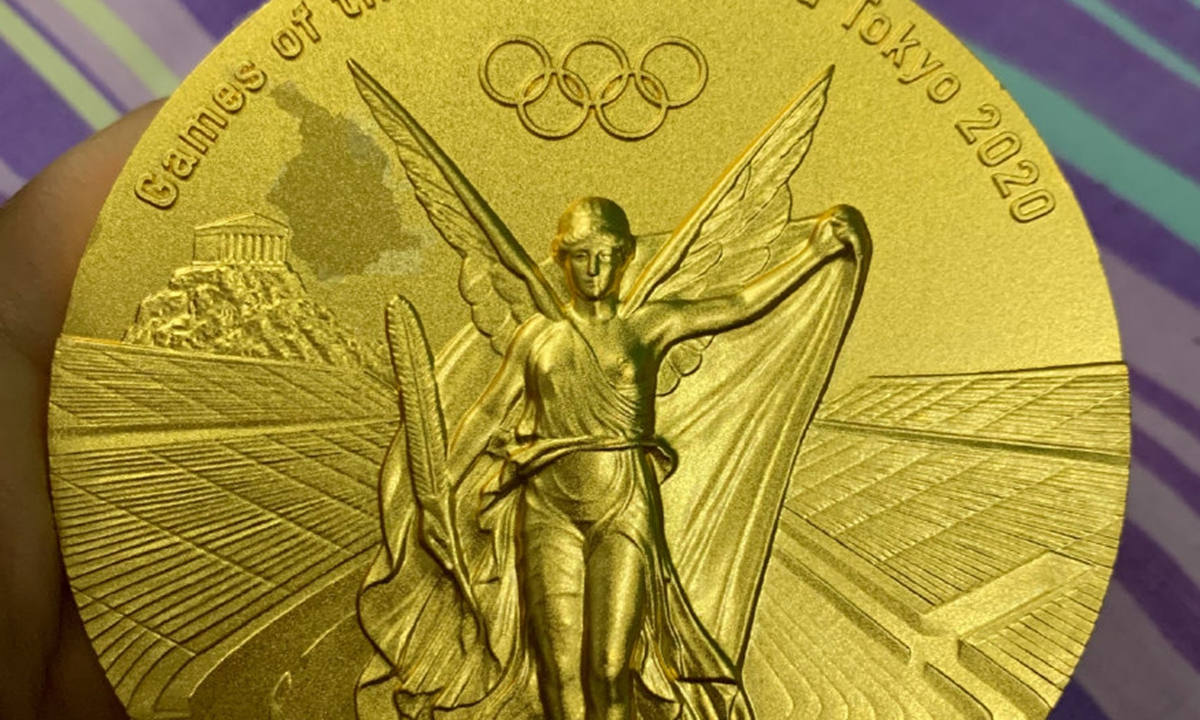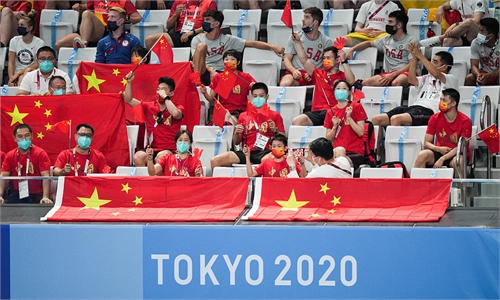'Quality' issue with Chinese trampoline athlete Zhu Xueying's Tokyo Olympic gold medal sparks discussion on Sina Weibo
‘Quality’ issue with Chinese trampoline athlete Zhu Xueying’s Tokyo Olympic gold medal sparks discussion on Sina Weibo

Zhu's gold medal. Photo: Sina Weibo
After the "quality" issue with Chinese trampoline athlete Zhu Xueying's Tokyo Olympic gold medal was exposed, the Organizing Committee of Tokyo Olympic Games told the Global Times on Wednesday that the part of the medal that came off was not the gold plating, but a coating applied to the surface of the medal. The committee noted that the thin coating is meant to prevent small scratches and stains from appearing on the medals."It does not affect the quality of the medal itself," said the committee.
On Saturday, Zhu donated her gold medal and the uniform she wore at the Games to the Tianjin Sports Museum. According to Zhu, the donation was made to pass on the Olympic spirits and so more people could have the chance to see an Olympic gold medal. Zhu is the first Chinese athlete to donate a Tokyo Olympic gold medal.
A group of photos posted to China's Sina Weibo on Monday night showing the gold medal won by Chinese trampoline athlete Zhu Xueying at the Tokyo Olympic Games has sparked a discussion concerning the "quality" of the medals made for the recent Games.
In three sequential photos Zhu shows that her medal had become damaged.
"Let me clarify this… I didn't mean to peel the thing off at first, I just discovered that there was a small mark (like pic one) on my medal. I thought that it was probably just dirt, so I rubbed it with my finger and found that nothing changed, so then I picked at it and the mark got bigger," Zhang posted in a comment under the photos.
The fact that a medal from the Tokyo Game could be damaged captured the attention of netizens, who left nearly 10,000 comments on her post. Some said they found the situation both surprising and unacceptable, noting that the gold medalist's hard work should not be rewarded with a flawed medal.
The discussion about the gold medal expanded further after some netizens began comparing it to those made for the 2008 Beijing Olympic Games, which were inlaid with jade as well as plated with gold.
"I once saw a news report that said a foreign athlete [Russian gymnast Daria Valeryevna] had a fire break out in her place. Many things got burnt, but not her medal. The old Chinese saying 'Real gold does not fear the test of fire' holds true," Zhang Xue, a netizen in Beijing, told the Global Times on Tuesday.
"The fact that the medals for the Tokyo Games were made from recycled materials is too experimental for me. Those medalists deserve something more valuable," posted a netizen on Sina Weibo.
The Tokyo medals were indeed a new experiment for the Olympic Games as they were made from metal extracted from electronic devices donated by people in Japan.
Around 20 people of Japan Mint have worked on the medals' production, the process including using machine to print the front and back sides, coloring, and so forth. The 2020 Tokyo Olympics medals have a diameter of 85 millimeters, and the weight of the gold medal is about 556 grams.
On Tuesday, Japan Mint, the medal maker for the Tokyo Games, told the Global Times that it has not noticed any issues regarding layers peeling off gold medals and that the Tokyo organizing committee may conduct a further investigation into the incident.
Despite the doubts about the Tokyo medals' quality, some people said they understand Japan's decision to use recycled materials.
"The medal's value can be defined by the symbolic meaning behind it, not just how expensive the materials used to make it are. The same goes for China's jade and gold medal. Japan's recycling design actually represents the idea of sustainability and consciousness. These things are regarded as virtues in Japanese culture," Dylan Yang, a Chinese designer, told the Global Times.


